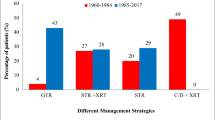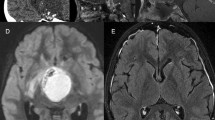Abstract
Purpose
To report our experience and management strategies during 10 years for 137 childhood craniopharyngiomas treated at a single institution.
Methods
Medical records of children with craniopharyngioma treated at Children’s Cancer Hospital Egypt (CCHE-57357) from July 2007 to December 2017 were retrospectively reviewed. Beta-catenin as an immunohistochemical marker was assessed also in available specimens.
Results
Our registry included 137 patients. Headache (n = 122), visual failure (n = 118), and hypothyroidism(n = 78) were the most common findings on presentation. Three management protocols were identified; 65 patients were primarily followed up after surgery, 71 patients had radiotherapy after surgery, and one patient underwent surgery for Ommaya insertion with intracystic interferon injection. Overall, gross total resection/near total resection was achieved in 48 cases (35.04%), subtotal resection was achieved in 58 patients (42.33%), 29 (21.16%) had biopsy and Ommaya reservoir, and two patients with calcified lesions had no operations. Fifty-four patients showed recurrence/progression of their lesions. Allover, 5-year progression-free survival (PFS) was 52.3%, while it was 34.49% and 72.25% for the follow-up group and the radiotherapy group, respectively. Beta-catenin mutations were positive in 61/95 patients; 5-year PFS for beta-catenin negative and positive cases was 65.5% and 39.4% respectively (p = 0.087). Mortality was reported in eight patients. Intraoperative endoscopy-assisted assessment was the cornerstone of tailored decision-making.
Conclusion
The concepts of conservative surgery and multimodal management should be applied to reach the perfect balance between the quality of life and the best tumor control rates. Beta-catenin mutations more than 5% are associated with statistically trending aggressive clinical behavior. The CCHE-57357 algorithm of individualized management protocol was presented.





Similar content being viewed by others
References
Minamida Y, Mikami T, Hashi K, Houkin K (2005) Surgical management of the recurrence and regrowth of craniopharyngiomas. J Neurosurg 103(2):224–232
Mortini P, Losa M, Pozzobon G, Barzaghi R, Riva M, Acerno S, Angius D, Weber G, Chiumello G, Giovanelli M (2011) Neurosurgical treatment of craniopharyngioma in adults and children: early and long-term results in a large case series. J Neurosurg 114(5):1350–1359
Müller HL, Merchant TE, Puget S, Martinez-Barbera JP (2017) New outlook on the diagnosis, treatment and follow-up of childhood-onset craniopharyngioma. Nat Rev Endocrinol 13(5):299–312
Sainte-Rose C, Puget S, Wray A, Zerah M, Grill J, Brauner R, Boddaert N, Pierre-Kahn A (2005) Craniopharyngioma: the pendulum of surgical management. Childs Nerv Syst 21(8–9):691–695
Larkin S, Karavitaki N (2017) Recent advances in molecular pathology of craniopharyngioma. F1000Res.;6:1202
Nielsen EH, Feldt-Rasmussen U, Poulsgaard L, Kristensen LØ, Astrup J, Jørgensen JO, Bjerre P, Andersen M, Andersen C, Jørgensen J, Lindholm J (2011) Incidence of craniopharyngioma in Denmark (n=189) and estimated world incidence of craniopharyngioma in children and adults. J Neuro-Oncol 104(3):755–763
Ostrom QT, Gittleman H, Xu J, Kromer C, Wolinsky Y, Kruchko C, Barnholtz-Sloan JS (2016) CBTRUS statistical report: primary brain and other central nervous system tumors diagnosed in the United States in 2009–2013. Neuro Oncol 18(suppl_5):v1–v75
Stiller CA, Bayne AM, Chakrabarty A, Kenny T, Chumas P (2019) Incidence of childhood CNS tumours in Britain and variation in rates by definition of malignant behaviour: population-based study. BMC Cancer 19(1):139
Bunin GR, Surawicz TS, Witman PA, Preston-Martin S, Davis F, Bruner JM (1998) The descriptive epidemiology of craniopharyngioma. J Neurosurg 89(4):547–551
Clark AJ, Cage TA, Aranda D, Parsa AT, Sun PP, Auguste KI, Gupta N (2013) A systematic review of the results of surgery and radiotherapy on tumor control for pediatric craniopharyngioma. Childs Nerv Syst 29(2):231–238
Apps JR, Martinez-Barbera JP (2016) Molecular pathology of adamantinomatous craniopharyngioma: review and opportunities for practice. Neurosurg Focus 41(6):E4
Brastianos PK, Taylor-Weiner A, Manley PE, Jones RT, Dias-Santagata D, Thorner AR, Lawrence MS, Rodriguez FJ, Bernardo LA, Schubert L, Sunkavalli A (2014) Exome sequencing identifies BRAF mutations in papillary craniopharyngiomas. Nat Genet 46(2):161–165
Klimo P, Venable GT, Boop FA, Merchant TE (2015) Recurrent craniopharyngioma after conformal radiation in children and the burden of treatment. J Neurosurg Pediatr 15(5):499–505
Martinez-Barbera JP, Buslei R (2015) Adamantinomatous craniopharyngioma: pathology, molecular genetics and mouse models. J Pediatr Endocrinol Metabol 28(1–2):7–17
Cohen M, Bartels U, Branson H, Kulkarni AV, Hamilton J (2013) Trends in treatment and outcomes of pediatric craniopharyngioma, 1975–2011. Neuro-Oncology 15(6):767–774
Müller HL, Gebhardt U, Teske C, Faldum A, Zwiener I, Warmuth-Metz M, Pietsch T, Pohl F, Sörensen N, Calaminus G (2011) Post-operative hypothalamic lesions and obesity in childhood craniopharyngioma: results of the multinational prospective trial KRANIOPHARYNGEOM 2000 after 3-year follow-up. Eur J Endocrinol 165(1):17–24
Schoenfeld A, Pekmezci M, Barnes MJ, Tihan T, Gupta N, Lamborn KR, Banerjee A, Mueller S, Chang S, Berger MS, Haas-Kogan D (2012) The superiority of conservative resection and adjuvant radiation for craniopharyngiomas. J Neuro-Oncol 108(1):133–139
Tomita T, Bowman RM (2005) Craniopharyngiomas in children: surgical experience at Children’s Memorial Hospital. Childs Nerv Syst 21(8–9):729–746
Caldarelli M, Massimi L, Tamburrini G, Cappa M, Di Rocco C (2005) Long-term results of the surgical treatment of craniopharyngioma: the experience at the Policlinico Gemelli, Catholic University, Rome. Childs Nerv Syst 21(8–9):747–757
De Vile CJ, Grant DB, Kendall BE, Neville BG, Stanhope R, Watkins KE, Hayward RD (1996) Management of childhood craniopharyngioma: can the morbidity of radical surgery be predicted? J Neurosurg 85(1):73–81
Elliott RE, Hsieh K, Hochm T, Belitskaya-Levy I, Wisoff J, Wisoff JH (2010) Efficacy and safety of radical resection of primary and recurrent craniopharyngiomas in 86 children. J Neurosurg Pediatr 5(1):30–48 1
Hoffman HJ, De Silva M, Humphreys RP, Drake JM, Smith ML, Blaser SI (1992) Aggressive surgical management of craniopharyngiomas in children. J Neurosurg 76(1):47–52
Poretti A, Grotzer MA, Ribi K, Schönle E, Boltshauser E (2004) Outcome of craniopharyngioma in children: long-term complications and quality of life. Dev Med Child Neurol 46(4):220–229
Yaşargil MG, Curcic M, Kis M, Siegenthaler G, Teddy PJ, Roth P (1990) Total removal of craniopharyngiomas: approaches and long-term results in 144 patients. J Neurosurg 73(1):3–11
Puget S, Garnett M, Wray A, Grill J, Habrand JL, Bodaert N, Zerah M, Bezerra M, Renier D, Pierre-Kahn A, Sainte-Rose C (2007) Pediatric craniopharyngiomas: classification and treatment according to the degree of hypothalamic involvement. J Neurosurg 106(1):3–12
Clusmann H, Höllig A (2019) Craniopharyngioma: the benefits of a conservative approach. Dtsch Artzebl Int 116(18):319
Elowe-Gruau E, Beltrand J, Brauner R, Pinto G, Samara-Boustani D, Thalassinos C, Busiah K, Laborde K, Boddaert N, Zerah M, Alapetite C (2013) Childhood craniopharyngioma: hypothalamus-sparing surgery decreases the risk of obesity. J Clin Endocrinol Metab 98(6):2376–2382 1
Cavalheiro S, Dastoli PA, Silva NS, Toledo S, Lederman H, Da Silva MC (2005 Aug 1) Use of interferon alpha in intratumoral chemotherapy for cystic craniopharyngioma. Childs Nerv Syst 21(8–9):719–724
Cavalheiro S, Di Rocco C, Valenzuela S, Dastoli PA, Tamburrini G, Massimi L, Nicacio JM, Faquini IV, Ierardi DF, Silva NS, Pettorini BL (2010) Craniopharyngiomas: intratumoral chemotherapy with interferon-α: a multicenter preliminary study with 60 cases. Neurosurg Focus 28(4):E12
Kilday JP, Caldarelli M, Massimi L, Chen RH, Lee YY, Liang ML, Parkes J, Naiker T, Van Veelen ML, Michiels E, Mallucci C (2017) Intracystic interferon-alpha in pediatric craniopharyngioma patients: an international multicenter assessment on behalf of SIOPE and ISPN. Neuro-oncology. 19(10):1398–1407
Kiehna EN, Merchant TE (2010) Radiation therapy for pediatric craniopharyngioma. Neurosurg Focus 28(4):E10
Merchant TE, Kiehna EN, Sanford RA, Mulhern RK, Thompson SJ, Wilson MW, Lustig RH, Kun LE (2002) Craniopharyngioma: the St. Jude children’s research hospital experience 1984–2001. Int J Radiat Oncol Biol Phys 53(3):533–542
Wang G, Zhang X, Feng M, Guo F (2018) Comparing survival outcomes of gross total resection and subtotal resection with radiotherapy for craniopharyngioma: a meta-analysis. J Surg Res 226:131–139
Šteňo J, Bízik I, Šteňo A, Matejčík V (2011) Craniopharyngiomas in children: how radical should the surgeon be? Childs Nerv Syst 27(1):41–54
Cheng WY, Chang CS, Shen CC, Wang YC, Sun MH, Hsieh PP (2001) Endoscope-assisted microsurgery for treatment of a suprasellar craniopharyngioma presenting precocious puberty. Pediatr Neurosurg 34(5):247–251
Ichikawa T, Otani Y, Ishida J, Fujii K, Kurozumi K, Ono S, Date I (2016) Hybrid microscopic-endoscopic surgery for craniopharyngioma in neurosurgical suite: technical notes. World Neurosurg. 85:340–348
Kadri H, Mawla AA (2006) Endoscopy-assisted microsurgical total resection of craniopharyngioma in childhood. Minim Invasive Neurosurg 49(06):369–372
Gupta DK, Ojha BK, Sarkar C, Mahapatra AK, Sharma BS, Mehta VS (2006) Recurrence in pediatric craniopharyngiomas: analysis of clinical and histological features. Childs Nerv Syst 22(1):50–55
Lynch JC, Pereira C, Manicacci V, Gonçalves M, Welling L, Lenk R (2016) The extended pterional approach and microsurgery resection for craniopharyngiomas, operative nuances and results: a series of 29 patients. Arquivos Brasileiros de Neurocirurgia: Brazilian Neurosurgery 35(03):197–206
Rogers M, Davies DM, Pal A, Marland A, Foord T, Jafar-Mohammadi B (2018) Characterisation of paediatric craniopharyngiomas in a single centre study–analysis of factors affecting recurrence rates. In Society for Endocrinology BES 59:p133. https://doi.org/10.1530/endoabs.59.P133
Prieto R, Pascual JM, Subhi-Issa I, Jorquera M, Yus M, Martínez R (2013) Predictive factors for craniopharyngioma recurrence: a systematic review and illustrative case report of a rapid recurrence. World Neurosurg 79(5–6):733–749
Tena-Suck ML, Salinas-Lara C, Arce-Arellano RI, Rembao-Bojórquez D, Morales-Espinosa D, Sotelo J, Arrieta O (2006) Clinico-pathological and immunohistochemical characteristics associated to recurrence/regrowth of craniopharyngiomas. Clin Neurol Neurosurg 108(7):661–669
Guadagno E, de Divitiis O, Solari D, Borrelli G, Bracale UM, Di Somma A, Cappabianca P, De Caro MD (2017) Can recurrences be predicted in craniopharyngiomas? β-catenin coexisting with stem cells markers and p-ATM in a clinicopathologic study of 45 cases. J Exp Clin Res 36(1):95
Li Z, Xu J, Huang S, You C (2015) Aberrant membranous expression of β-catenin predicts poor prognosis in patients with craniopharyngioma. Ann Diagn Pathol 19(6):403–408
Kalapurakal JA (2005) Radiation therapy in the management of pediatric craniopharyngiomas—a review. Childs Nerv Syst 21:808–816
Mizowaki T, Ogura K, Sakanaka K, Uto M, Arakawa Y, Hojo M, Miyamoto S, Hiraoka M (2016) Long-term outcomes of conventionally-fractionated high-precision radiotherapy for craniopharyngioma. Japanese Journal of Neurosurgery 25(8):646–653
Author information
Authors and Affiliations
Corresponding author
Ethics declarations
Conflict of interest
The authors declare that they have no conflict of interest in personal, financial, institutional, or industry affiliations in any of the drugs, materials, or devices described in this article. The authors have no conflicts that may affect ethical adherence.
Additional information
Publisher’s note
Springer Nature remains neutral with regard to jurisdictional claims in published maps and institutional affiliations.
Rights and permissions
About this article
Cite this article
Enayet, A.E.R., Atteya, M.M.E., Taha, H. et al. Management of pediatric craniopharyngioma: 10-year experience from high-flow center. Childs Nerv Syst 37, 391–401 (2021). https://doi.org/10.1007/s00381-020-04833-x
Received:
Accepted:
Published:
Issue Date:
DOI: https://doi.org/10.1007/s00381-020-04833-x




